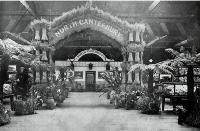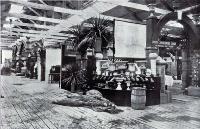The Provincial Courts
- The local government organisations of all the provincial areas of New Zealand, except for Wellington and Otago, contributed courts to the Exhibition.
- Most courts concentrated on displays of agricultural and mineral products, with a strong emphasis on exhibits of wool, grains, dairy products, coal and gold.
Provincial Produce
The exhibits of the Provincial courts provided an opportunity for local government organisations to promote the industries and products of their region. The varied resources and geography across provinces meant these covered a wide range indeed.
Animal…
Dairying dominated the exhibits from Waikato, Hawke’s Bay and Manawatu. Naturally sheep farming also featured with the finest wool, winning many prizes, appearing in the North Canterbury court. More specialised crops included goat skins and angora fibre from Marlborough and ostrich-farming in Auckland and North Canterbury.
Vegetable…
North Canterbury and the West Coast had substantial examples of timber-milling and timber products, while the Auckland court contained an especially fine kauri gum display, based on the collection of the Hon. E. Mitchelson. In addition Auckland and Hawke's Bay offered "an excellent display of the great fruit-growing and wine-producing capabilities of this well-favoured district".1 Wine also featuring in the Waikato, Wanganui and Marlborough courts. Flax-milling and hemp-making were significant elements in several courts, including Manawatu (Foxton was a major centre for this industry), Waikato, and Marlborough. Also present were hops from Nelson, and South Canterbury’s grains and cereals which "epitomized the varied products of this pleasant and fertile part of the colony".2
…And Mineral
Mineral wealth was shown through exhibits of gold and coal, but also in ironsands and petroleum from Taranaki, pounamu (greenstone), silver-ores and other minerals from the West Coast, and building stones from North Canterbury and elsewhere.
Artistic Displays
Only Westland and the north and south Canterbury courts combined these down to earth displays with "ornamental" additions: paintings, flowers, ferns, corn sheaves and flax. South Canterbury won the competition for "Best District Court", but some thought that North Canterbury was "highly picturesque and in some respects unique".3 It was the only provincial court to include an early history exhibit, a pictorial and documentary record of early European settlement, which included pictures, immigration posters, sketches by Dr Alfred Charles Barker, Canterbury Association and Provincial Council books and documents, the Speaker's chair from the Provincial Council and the first issue of the Lyttelton Times.
Cowan was even more enthusiastic about the West Coast court was even more enthusiastically described as it was, "in many respects a model court ... a complete museum of the West Coast".4 Its immense variety of exhibits offered a comprehensive display of raw materials and finished articles from the province, and its "picture-crammed walls"5 showed a "fairy region of forest and fern, of blue-hazed mountain and calm wood-belted lake, of Himalayan icefalls and snowfields".6
Wanganui was the only other court with a large art display; it featured the photography of Frank Denton (1869-1963), who had opened his commercial premises, Tesla studios, in the town in 1899. A few courts contained examples of Māori weaving and other artefacts, and South Canterbury had an attractive sporting section, with trout, wild ducks and geese, wild pigs and other game featured.
Scale models
In the Provincial Courts there were few working models or other eye-catching demonstrations of New Zealand's wealth-making and nation-making pursuits to be seen. North Canterbury showed a working model of Lyttelton Harbour with the railway line to Christchurch, as well as relief models of Banks Peninsula and Onawe Peninsula. A large model of an 1846 blockhouse erected by early settlers in Akaroa, and a large relief model of Timaru Harbour adorned the South Canterbury court, but the only other models on display were an excellent collection of the scows and other ships of the Northern Steamship Company in the Auckland court.
While the courts generally represented New Zealand’s present wealth and future potential adequately, some remarked that it was disappointing that Auckland was not represented, and Sir Joseph Ward in his opening address expressed sorrow that Wellington and Otago, two of the country’s major economic regions, were absent from the Exhibition.
![]()
Related photos
 The North Canterbury Court |
 The South Canterbury Court in preparation |




